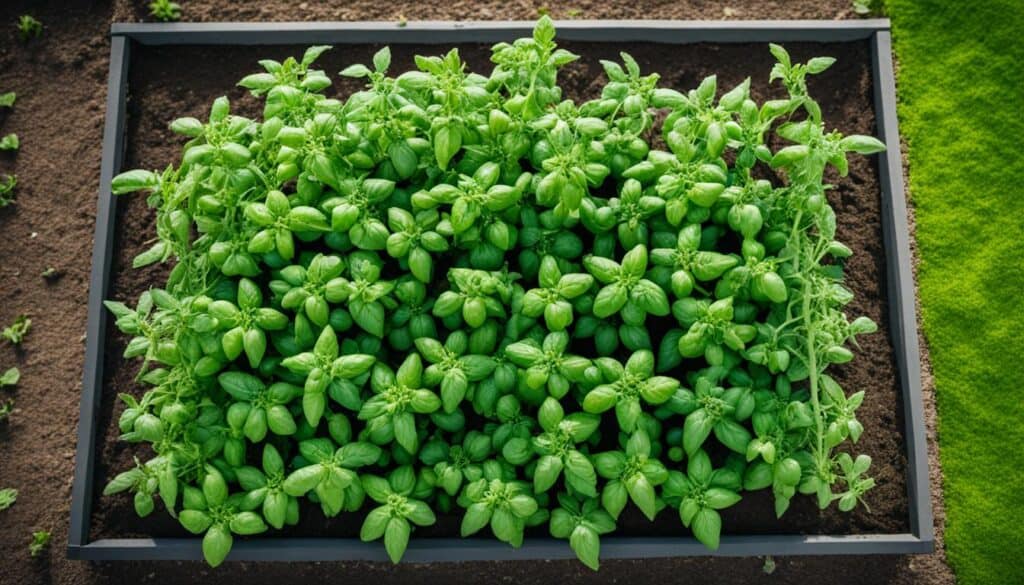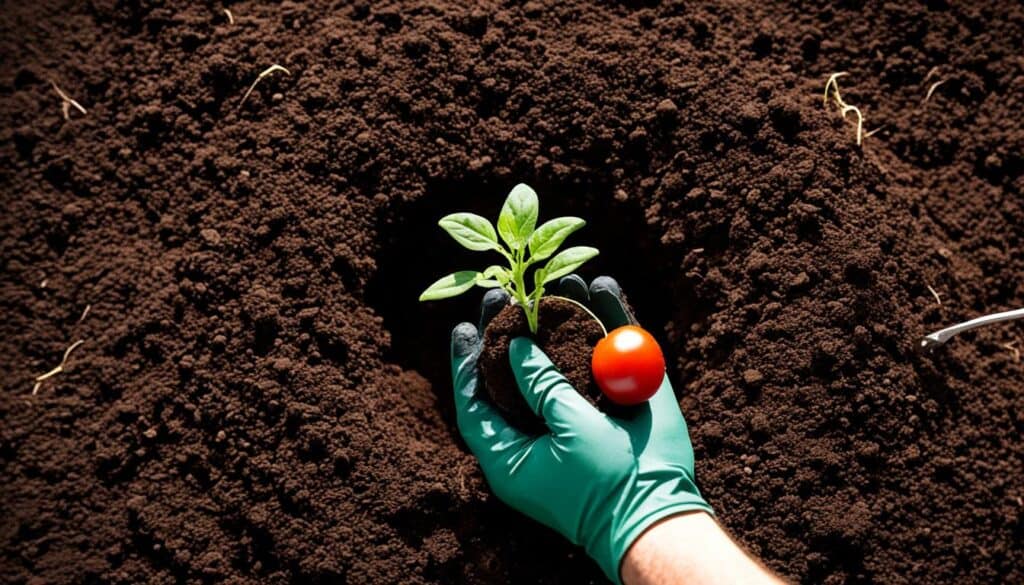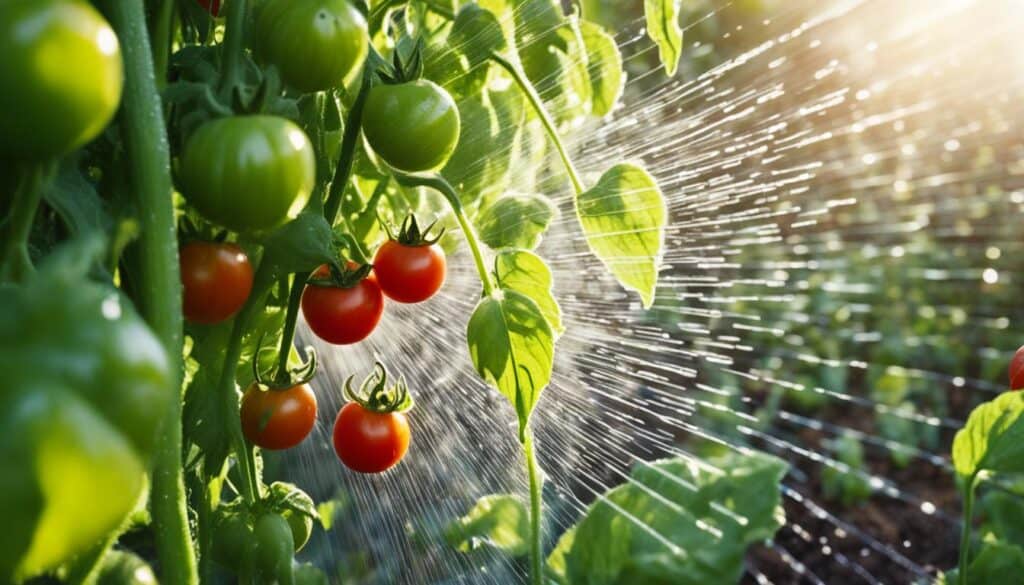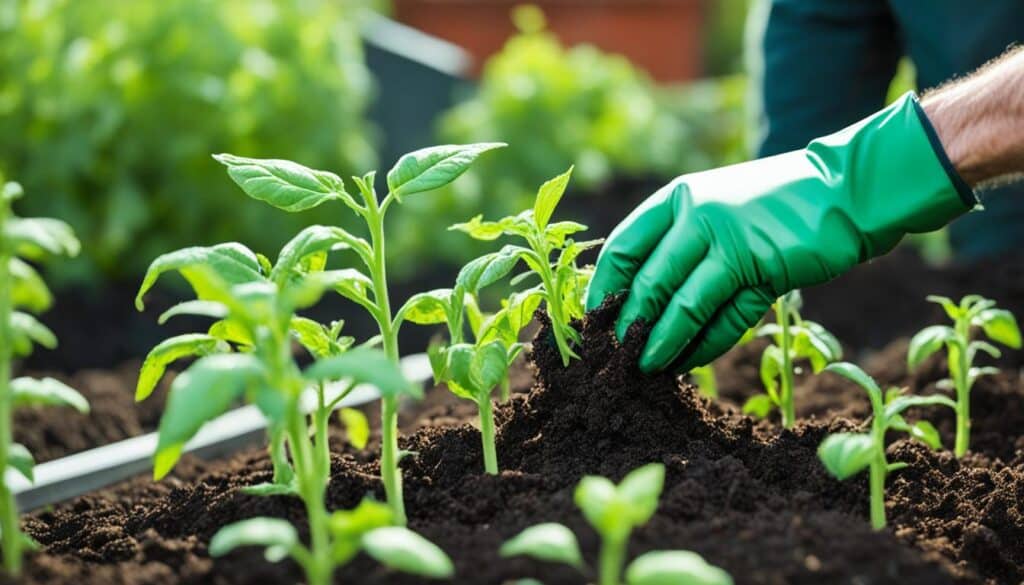Did you know that tomatoes are the most commonly grown vegetable in home gardens across the United States? That’s right! Whether you’re a seasoned gardener or just starting out, tomatoes are a popular choice for their versatility, taste, and abundance.
But growing healthy and productive tomato plants requires more than just planting a few seeds and hoping for the best. To ensure a bountiful tomato crop, you need to follow expert tips and best practices for tomato gardening.
Key Takeaways:
- Prepare your garden by ensuring well-worked soil and good drainage.
- Warm the soil for early planting to enjoy an earlier crop.
- Give your tomatoes ample space to grow tall and wide.
- Bury tomato seedlings deep for stronger plants.
- Fertilize tomatoes appropriately for optimal growth and fruit production.
These are just a few of the essential tips that will help you on your journey to tomato garden success. From selecting the right tomato varieties to proper care and maintenance, each step plays a crucial role in maximizing your harvest. So let’s dig in and learn how to grow tomatoes like a pro!
Prepare the Garden for Tomato Planting
Before you start planting your tomato garden, it’s important to prepare the soil and create an optimal environment for your plants to thrive. Here are some steps to get your garden ready for tomato planting:
- Choose a sunny location: Tomatoes love sun, so select a spot in your garden that receives at least 6-8 hours of direct sunlight each day. This will ensure that your tomato plants have ample light to grow and produce delicious garden tomatoes.
- Work the soil: Start by digging down and removing any rocks, weeds, or roots from the planting area. Tomatoes prefer well-worked soil that is loose and free of debris. This will provide them with a healthy environment for root development and growth.
- Ensure good drainage: Tomato plants like well-drained soil to prevent waterlogged roots and disease. If your garden soil is heavy or doesn’t drain well, consider amending it with organic matter or creating raised beds to improve drainage.
- Add organic matter: Incorporate organic matter into the soil to enhance its fertility and structure. Compost, well-rotted manure, or shredded newspaper are excellent choices. This will improve nutrient retention, moisture levels, and overall soil health for your tomato plants.
- Define your planting plot: Mark out the area where you will be planting your tomatoes. This will help you visualize the spacing and arrangement of your plants. Consider using a cage or support structure for your tomato plants, especially if you are growing indeterminate varieties that can grow tall and require support.
- Plan walkways: Designate walkways between your tomato plants to ensure easy access for maintenance tasks such as watering, pruning, and harvesting. Well-planned walkways will also prevent soil compaction and minimize damage to the plants as you move around the garden.
By following these steps to prepare your garden for tomato planting, you’ll create an ideal growing environment for your tomato plants. This will set the stage for a successful and bountiful tomato harvest.
Expert Tip:
“Well-prepared soil and good drainage are crucial for the successful cultivation of garden tomatoes. Take the time to dig down, remove any debris, and incorporate organic matter to create a nutrient-rich and well-structured planting bed.”
Warm the Soil for Early Planting
If you want to start planting your tomatoes earlier in the season, you can warm the soil by using plastic sheeting or landscape cloth. By trapping the heat from the sun, these materials can warm the soil, allowing you to plant your tender tomato seedlings earlier than usual. Warm soil is essential for the successful growth of tomato plants and can even result in an earlier crop, rewarding you with delicious tomatoes sooner.
“If you want to get a head start on your tomato garden, warming the soil is key. Using plastic sheeting or landscape cloth can trap heat and create a warmer environment for your tomato seedlings. This not only allows for early planting but also encourages faster growth and an earlier harvest. It’s like giving your tomatoes a head start on the growing season!”
Transplanting tomato seedlings into warm soil provides the perfect environment for their roots to establish and grow. The increased garden temperature accelerates their development, enabling them to absorb more nutrients and water, leading to stronger and healthier plants. Additionally, tomato seedlings planted in warm soil have a better chance of avoiding common issues like transplant shock and stunted growth.
For visual guidance, refer to the table below:
| Materials | Benefits |
|---|---|
| Plastic Sheeting | Traps heat from the sun, warming the soil |
| Landscape Cloth | Provides insulation, promoting earlier planting |
In addition to elevated soil temperatures, using plastic sheeting or landscape cloth can help conserve moisture and prevent weed growth. The covering creates a barrier that retains soil moisture, reducing the need for frequent watering. Less competition from weeds also ensures that the tomato seedlings have access to the necessary nutrients and space to thrive.
To visually emphasize the benefits of warming the soil, take a look at the following image:
Give Tomatoes Ample Space
Tomatoes need plenty of space to grow and flourish, both in terms of their height and width. Providing them with adequate room to spread their branches and reach for the sun is essential for achieving the best yield of healthy and abundant tomatoes. To ensure optimal growth and maximize your harvest, follow these tips for giving your tomatoes ample space.
Plant Spacing
When it comes to planting tomatoes, one of the crucial factors to consider is the spacing between plants. Leaving enough room between each tomato plant allows them to grow without competing for resources and ensures proper sunlight penetration. For optimal results, leave a spacing of at least 18-20 inches between each plant. This spacing allows the plants to spread out, encouraging tall and wide growth, which leads to a bountiful harvest.
Proper plant spacing not only allows each tomato plant to receive ample sunlight but also promotes airflow, reducing the risk of diseases caused by excess moisture and overcrowding. With adequate space between the plants, they can efficiently absorb sunlight, leading to better photosynthesis and higher energy production for robust growth and fruit development.
Stretching Space
As your tomato plants grow, they will need additional space to stretch out their branches. Providing enough stretching space prevents overcrowding, which can lead to a cramped and unhealthy environment for the plants. Adequate stretching space allows each plant to spread out without tangling or shading neighboring plants, enabling proper air circulation and reducing the risk of diseases.
When planning your garden layout, consider the mature size of the tomato plants you are growing. Indeterminate varieties, which continue to grow and produce fruit throughout the growing season, generally require more stretching space than determinate varieties. Give indeterminate tomatoes even more room to accommodate their vigorous growth habit.
Ample Sun Exposure
Tomatoes are sun-loving plants that thrive in full sun. Providing ample sun exposure is crucial for their development and productivity. By giving your tomato plants sufficient space, you allow them to spread out and capture as much sunlight as possible, ensuring optimal photosynthesis.
Sunlight is essential for the production of sugars and chlorophyll in the leaves, which are crucial for the plant’s energy production and growth. Ample sun exposure also promotes flower development and fruit set, leading to a better yield of tasty tomatoes.
By following these guidelines and giving your tomatoes ample space, you can create an optimal growing environment that allows for healthy and productive plants. Remember to consider both plant spacing and stretching space to accommodate the specific needs of your tomato varieties and ensure they receive ample sunlight for optimal growth and the best yield of delicious tomatoes.
Bury Tomato Seedlings for Stronger Plants
When it comes to transplanting tomato seedlings, one of the best techniques for promoting healthier and stronger plants is to bury them deep in the soil. By leaving only the top few layers of leaves above ground, you encourage the development of stronger and deeper roots in your tomato plants. This not only provides a more stable foundation for the plant but also enhances its ability to absorb nutrients and water from the soil.
Shallow planting, on the other hand, can lead to issues like spindly stems and smaller tomatoes. When the seedlings are not planted deep enough, their roots remain close to the surface, unable to reach the necessary resources for optimal growth. By burying the seedlings, you ensure that the roots have ample space to spread out and establish a strong foundation for the plant.
In addition to promoting better root development, burying tomato seedlings can also help prevent blossom rot, a common problem that affects tomato plants. Blossom rot is characterized by black or brown patches at the blossom end of the fruit, and it is caused by a calcium deficiency in the plant. By adding sources of calcium, such as crushed eggshells or bone meal, to the planting hole while burying the seedlings, you can provide the necessary nutrients to prevent this condition and ensure healthy fruit development.
So, don’t be afraid to bury those tomato seedlings deep in the soil. The result will be stronger, healthier plants with deeper roots, giving you a better chance of a successful tomato harvest. Remember to add eggshells or bone meal to the planting hole to prevent blossom rot and enjoy a bountiful crop of delicious tomatoes.
Fertilize Tomato Plants Appropriately
Tomato plants have specific nutrient needs, and it’s important to fertilize them appropriately to ensure healthy growth and a bountiful harvest. By providing the right combination of essential nutrients, you can promote the development of strong plants and optimize fruit production. Here are some key tips for fertilizing tomato plants:
1. Incorporate Eggshells or Bone Meal
One natural way to provide calcium to your tomato plants is by adding eggshells or bone meal to the planting hole. The calcium supplied by these organic materials helps prevent blossom rot, a common problem in tomato plants. Simply crush the eggshells or mix a tablespoon of bone meal into the soil before planting your tomato seedlings.
2. Use a Commercial Fertilizer
In addition to organic amendments, using a commercial fertilizer can provide the necessary nutrients for optimal tomato growth. When selecting a fertilizer, look for one with lower first numbers such as 6-12-12. This means the fertilizer contains more phosphorus and potash but less nitrogen. Tomatoes require higher levels of phosphorus and potash for healthy fruit development and less nitrogen to discourage excessive foliage growth.
3. Choose Lower First Numbers
The ratio of the three numbers on a fertilizer package represents the relative amounts of nitrogen (N), phosphorus (P), and potassium (K) in the product. The first number indicates the percentage of nitrogen, the second number represents phosphorus, and the third number is potassium. To promote more fruit production and less foliage growth, choose a fertilizer with lower first numbers (lower nitrogen content) to ensure your tomato plants receive the appropriate balance of nutrients.
4. More Fruit, Less Foliage
By providing your tomato plants with the right nutrients, you can encourage them to produce more fruit and less foliage. Too much nitrogen can result in excessive leafy growth at the expense of fruit production. By choosing a fertilizer with lower nitrogen content and higher levels of phosphorus and potash, you can strike the right balance and promote the development of abundant, tasty tomatoes.
| Fertilizer | Nitrogen (N) | Phosphorus (P) | Potassium (K) |
|---|---|---|---|
| 6-12-12 | 6% | 12% | 12% |
| 10-20-20 | 10% | 20% | 20% |
| 5-10-10 | 5% | 10% | 10% |
Table: Comparison of Commercial Fertilizers for Tomato Plants
Choosing the right fertilizer and providing your tomato plants with the correct nutrients will help them thrive and yield a bountiful harvest. By incorporating organic materials and selecting a fertilizer with lower first numbers, you can ensure your tomato plants receive the balanced nutrition they need for healthy growth and abundant fruit production.
Companion Planting with Basil
Basil and tomatoes are an ideal combination when it comes to companion planting. These two plants complement each other in many ways, resulting in larger and more vigorous growth for both. If you want to maximize the potential of your tomato garden, try planting basil alongside your tomato plants.
Studies have shown that basil can enhance the growth and flavor of tomatoes. The aromatic oils released by basil plants help repel pests that can damage tomatoes, while also enhancing their taste. The close proximity of basil to tomatoes also helps attract beneficial insects such as bees and butterflies, which aid in pollination.
One way to incorporate basil into your tomato garden is to plant it between tomato rows. This allows the two plants to grow alongside each other, benefiting from their mutually beneficial relationship. Alternatively, you can alternate planting basil and tomatoes in a checkerboard pattern throughout your garden.
Not only does companion planting with basil provide practical benefits for your tomato plants, but it also adds visual interest to your garden. The vibrant green leaves of basil contrast beautifully with the deep reds, yellows, and oranges of ripe tomatoes.
Furthermore, the culinary uses of basil are endless. From homemade sauces and pestos to flavorful salads and sandwiches, having fresh basil on hand will undoubtedly enhance your cooking and provide a delicious addition to your meals.
Benefits of Companion Planting Basil with Tomatoes:
- Enhanced growth and flavor for both plants
- Natural pest repellent for tomatoes
- Attracts beneficial insects for pollination
- Visual appeal and aesthetic contrast in the garden
- Culinary versatility and added flavor to meals
So, if you’re looking for a simple yet effective way to improve your tomato garden, give companion planting with basil a try. Not only will you enjoy larger and more robust tomatoes, but you’ll also have the added bonus of fresh basil for your culinary adventures.
Tomatoes Thrive with Basil Companionship
I have always found that planting basil alongside my tomatoes leads to better growth and tastier tomatoes. The flavors seem to meld together, and the plants seem to thrive in each other’s presence. It’s a win-win situation.” – Amy, Tomato Enthusiast
Proper Watering for Healthy Tomatoes
Consistent and adequate watering is key to producing healthy and flavorful tomatoes. To ensure optimal growth and prevent common issues, consider the following tips:
Deep Watering for Ample Supply
To promote root development and provide your tomatoes with a deep water supply, it’s important to water them deeply and thoroughly. This should be done two to three times a week, depending on weather conditions. Deep watering allows the roots to access water from lower soil layers, preventing issues like misshapen fruit, end rot, and cracking.
Avoid Shallow Daily Watering
While it may be tempting to water tomatoes daily, shallow watering can actually do more harm than good. Instead, focus on providing adequate water during each watering session. This practice encourages the roots to grow deep, resulting in stronger plants and better fruit production.
Water in the Morning
Optimal timing is essential when it comes to watering tomatoes. Water your plants in the morning to allow ample time for the leaves to dry throughout the day. This helps prevent the risk of root rot and fungal diseases caused by excess moisture. Additionally, morning watering ensures that the plants are adequately hydrated during the day, helping them withstand heat and sun exposure.
By following these watering practices, you’ll provide your tomatoes with the ideal conditions for uniform growth and tasty fruits. Deep, consistent watering, combined with appropriate sun exposure and other care techniques, will help you cultivate a successful tomato garden.
Pruning and Mulching Tomato Plants
When it comes to growing tomato plants, proper pruning and mulching are essential for their overall health and productivity. Pruning helps create adequate space for the plants to grow and promotes bushier growth, while mulching helps regulate the ground temperature, retain moisture, and prevent weed growth. Let’s explore these two important practices in detail:
Pruning Tomato Plants
Pruning tomato plants not only provides them with adequate space to flourish but also helps prevent disease and improve air circulation. By removing the bottom leaf clusters from the stem, you can reduce the risk of fungal issues and make tasks like weeding and mulching easier. Additionally, pruning allows the plants to focus their energy on producing abundant fruit.
“Pruning tomato plants encourages healthier growth and higher yields.” – Gardening Magazine
To prune tomato plants:
- Pinch off the suckers that develop in the leaf axils, which are the points where leaves join the stem.
- Remove any damaged or diseased branches.
- Thin out crowded areas to improve air circulation.
Mulching Tomato Plants
Mulching around tomato plants offers several benefits for their growth and productivity. It helps regulate the ground temperature, keeping it warm during cooler periods and cooler during hot spells. Mulch also helps retain moisture in the soil, reducing the need for frequent watering and preventing excessive evaporation.
Furthermore, mulching acts as a weed suppressant, preventing unwanted plants from competing with your tomatoes for nutrients and water. You can use various materials for mulching, including commercial mulches, shredded newspapers, straw, landscape fabric, or even plastic sheeting.
“Mulching not only benefits the soil and plants but also makes the garden look tidy and well-maintained.” – Horticulture Today
To mulch tomato plants:
- Wait until the soil has warmed up and the plants are established.
- Apply a layer of mulch, around 2-3 inches thick, around the base of the plants, making sure not to cover the stems directly.
- Extend the mulch in a radius around the plants to cover the entire root zone.
- Refresh the mulch as needed throughout the growing season.
| Mulching Materials | Pros | Cons |
|---|---|---|
| Commercial Mulch | – Professionally formulated for maximum benefits – Readily available |
– May be more expensive – Synthetic materials |
| Shredded Newspapers | – Cost-effective and environmentally friendly – Easily accessible |
– May blow away in strong winds – Requires a thicker layer to prevent weed growth |
| Straw | – Natural and organic – Good water retention |
– May harbor pests or fungal spores – May contain weed seeds |
| Landscape Fabric | – Controls weed growth effectively – Durable and long-lasting |
– Can restrict water penetration – Expensive upfront cost |
Choose the mulching material that suits your preferences and garden’s needs. Remember to replenish the mulch periodically to ensure its effectiveness throughout the growing season.
By incorporating the practice of pruning and mulching into your tomato garden routine, you can create an environment that promotes healthy growth, prevents diseases, and enhances the overall productivity of your plants.
Conclusion
With these expert tips, you can achieve success in your tomato garden and enjoy a bountiful crop. Proper preparation and planting are essential for healthy plants. Make sure to select the right tomato variety for your needs, considering factors like taste, size, and disease resistance. Give your plants ample space to grow by maintaining proper spacing, allowing for optimal sunlight and airflow.
Caring for your tomato plants involves consistent watering and pruning. Water deeply and thoroughly, ensuring that the soil remains evenly moist but not waterlogged. Prune your plants to remove suckers and promote better airflow, reducing the risk of diseases. Mulching around your tomato plants will help control soil temperature, retain moisture, and suppress weed growth.
Embrace organic gardening practices for a healthier tomato garden. Avoid synthetic pesticides and opt for natural alternatives to manage pests and diseases. Consider companion planting, such as basil, to enhance the growth and flavor of your tomatoes.
By following these expert tips on variety selection, planting and care, watering and pruning, and mulching and spacing, you’ll set yourself up for tomato garden success. Prepare, nurture, and tend to your plants with care, and you’ll soon be rewarded with a bountiful tomato crop that will bring joy to your meals and pride to your organic garden.










Leave a Reply